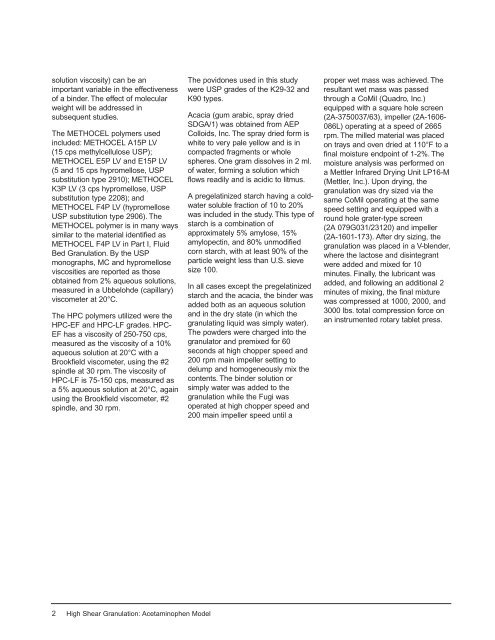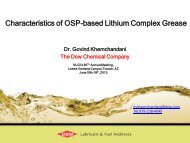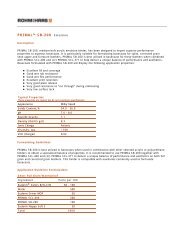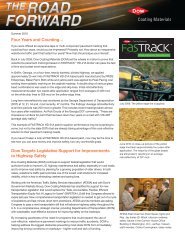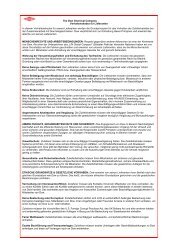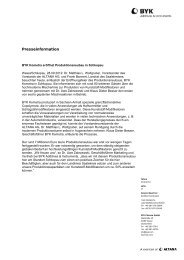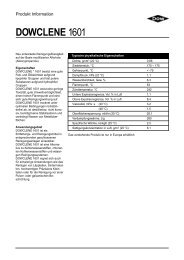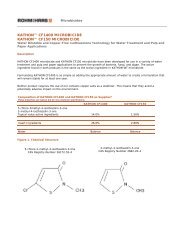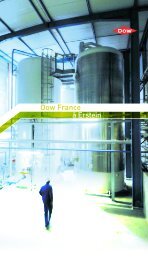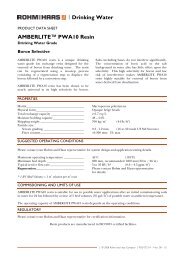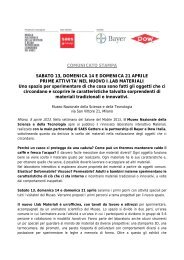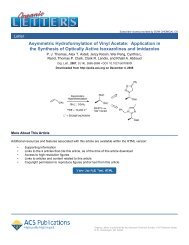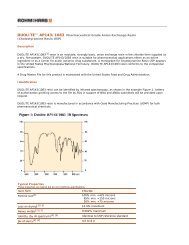Granulation with Dow Cellulosic Polymers II. High Shear Granulation
Granulation with Dow Cellulosic Polymers II. High Shear Granulation
Granulation with Dow Cellulosic Polymers II. High Shear Granulation
You also want an ePaper? Increase the reach of your titles
YUMPU automatically turns print PDFs into web optimized ePapers that Google loves.
solution viscosity) can be an<br />
important variable in the effectiveness<br />
of a binder. The effect of molecular<br />
weight will be addressed in<br />
subsequent studies.<br />
The METHOCEL polymers used<br />
included: METHOCEL A15P LV<br />
(15 cps methylcellulose USP);<br />
METHOCEL E5P LV and E15P LV<br />
(5 and 15 cps hypromellose, USP<br />
substitution type 2910); METHOCEL<br />
K3P LV (3 cps hypromellose, USP<br />
substitution type 2208); and<br />
METHOCEL F4P LV (hypromellose<br />
USP substitution type 2906). The<br />
METHOCEL polymer is in many ways<br />
similar to the material identified as<br />
METHOCEL F4P LV in Part I, Fluid<br />
Bed <strong>Granulation</strong>. By the USP<br />
monographs, MC and hypromellose<br />
viscosities are reported as those<br />
obtained from 2% aqueous solutions,<br />
measured in a Ubbelohde (capillary)<br />
viscometer at 20°C.<br />
The HPC polymers utilized were the<br />
HPC-EF and HPC-LF grades. HPC-<br />
EF has a viscosity of 250-750 cps,<br />
measured as the viscosity of a 10%<br />
aqueous solution at 20°C <strong>with</strong> a<br />
Brookfield viscometer, using the #2<br />
spindle at 30 rpm. The viscosity of<br />
HPC-LF is 75-150 cps, measured as<br />
a 5% aqueous solution at 20°C, again<br />
using the Brookfield viscometer, #2<br />
spindle, and 30 rpm.<br />
2 <strong>High</strong> <strong>Shear</strong> <strong>Granulation</strong>: Acetaminophen Model<br />
The povidones used in this study<br />
were USP grades of the K29-32 and<br />
K90 types.<br />
Acacia (gum arabic, spray dried<br />
SDGA/1) was obtained from AEP<br />
Colloids, Inc. The spray dried form is<br />
white to very pale yellow and is in<br />
compacted fragments or whole<br />
spheres. One gram dissolves in 2 ml.<br />
of water, forming a solution which<br />
flows readily and is acidic to litmus.<br />
A pregelatinized starch having a coldwater<br />
soluble fraction of 10 to 20%<br />
was included in the study. This type of<br />
starch is a combination of<br />
approximately 5% amylose, 15%<br />
amylopectin, and 80% unmodified<br />
corn starch, <strong>with</strong> at least 90% of the<br />
particle weight less than U.S. sieve<br />
size 100.<br />
In all cases except the pregelatinized<br />
starch and the acacia, the binder was<br />
added both as an aqueous solution<br />
and in the dry state (in which the<br />
granulating liquid was simply water).<br />
The powders were charged into the<br />
granulator and premixed for 60<br />
seconds at high chopper speed and<br />
200 rpm main impeller setting to<br />
delump and homogeneously mix the<br />
contents. The binder solution or<br />
simply water was added to the<br />
granulation while the Fugi was<br />
operated at high chopper speed and<br />
200 main impeller speed until a<br />
proper wet mass was achieved. The<br />
resultant wet mass was passed<br />
through a CoMil (Quadro, Inc.)<br />
equipped <strong>with</strong> a square hole screen<br />
(2A-3750037/63), impeller (2A-1606-<br />
086L) operating at a speed of 2665<br />
rpm. The milled material was placed<br />
on trays and oven dried at 110°F to a<br />
final moisture endpoint of 1-2%. The<br />
moisture analysis was performed on<br />
a Mettler Infrared Drying Unit LP16-M<br />
(Mettler, Inc.). Upon drying, the<br />
granulation was dry sized via the<br />
same CoMil operating at the same<br />
speed setting and equipped <strong>with</strong> a<br />
round hole grater-type screen<br />
(2A 079G031/23120) and impeller<br />
(2A-1601-173). After dry sizing, the<br />
granulation was placed in a V-blender,<br />
where the lactose and disintegrant<br />
were added and mixed for 10<br />
minutes. Finally, the lubricant was<br />
added, and following an additional 2<br />
minutes of mixing, the final mixture<br />
was compressed at 1000, 2000, and<br />
3000 lbs. total compression force on<br />
an instrumented rotary tablet press.


